AJKOER
Radically Dubious
    
Posts: 3026
Registered: 7-5-2011
Member Is Offline
Mood: No Mood
|
|
DISSOLVING IRON METAL- Interesting Non-Ionic Basic Ferrous Acetate and Ionic Ferric Acetate
I previously gave an example of a microwave assisted experiment creating a copper salt (see https://www.sciencemadness.org/whisper/viewthread.php?tid=15... ) from household vinegar ( 5% acetic acid, HOAc), a small piece of copper, dilute
3% hydrogen peroxide, sea salt, NaCl and a carbon source, C, (in the form of carbonized toast where ideally, the surface area of the carbon greatly
exceed that of the surface area of the metal). I have repeated that experiment with the following changes: replace copper with cast iron as sourced
from an iron rod, employed just 240 ml each for the H2O2 and vinegar, and for carbon, employed 3 small graphite rods (where the relative surface area
ratio was low, and not large as is ideal, see attached starting picture).
General chemistry related comments include that the employment of a microwave in the presence of carbon has been noted in the literature as leading to
the formation of powerful radicals, so this home lab preparation is more properly viewed, in my opinion, as a microwave assisted electrosynthesis
(see, for example, “Generation of hydroxyl radical in aqueous solution by microwave energy using activated carbon as catalyst and its potential in
removal of persistent organic substances” at https://www.researchgate.net/publication/239705822_Generatio... ). The presence of acidic radicals may also be of consequence (see
‘Radical-Enhanced Acidity: Why Bicarbonate, Carboxyl, Hydroperoxyl, and Related Radicals Are So Acidic’ at https://pubs.acs.org/doi/abs/10.1021/acs.jpca.7b08081?src=re... and also https://pubs.acs.org/doi/abs/10.1021/jp984769y?journalCode=j... and my prior comments on SM at http://www.sciencemadness.org/talk/viewthread.php?tid=94166).
The expected product in this synthesis include the possible formation of acetates and basic acetates of ferrous and ferric, the latter developing in
under a day.
OBSERVATIONS AND RESULTS
Pictures at various times during the reaction suggest major differences. First, there was compared with copper, much less gas bubbling during and
after a more extended 5 minute MW treatment of the H2O2/Fe/HOAc/NaCl system, at which time the vessel was sealed, and not re-opened. Second, I employ
less NaCl (like 2 pinches of large sea salt crystals, and as to why is discussed below) and together with the low unfavorable surface area ratio
between the metal and carbon, an extended 5 minute MW treatment was required to observe a good indication of reaction. Third, as indicated by early
photos, a scale soon develops (in minutes after treatment) on the surface of the solution, and in a few hours, the solution becomes increasingly more
off-white in color with an apparent non-ionic compound (ferrous acetate, hence the intentional limited use of the ionic NaCl electrolyte). And upon
checking some 15 hours later, the solution has turned reddish and more watery in appearance indicating formation of an ionic basic ferric acetate, in
spite of the presence of metal iron, that was now, however, coated with an oxide layer (likely from the consumption of the acetic acid with the
reddish coloration developing without ever opening of the vessel and exposure to external air).
DISCUSSION OF POSSIBLE ELECTROCHEMISTRY, SURFACE CHEMISTRY AND RADICAL REACTIONS
Generally, the anode is the electrode (or zone) where galvanic reaction(s) generate electrons and where anodic corrosion typically is observed.
Correspondingly, the cathode is the electrode that receives electrons and is protected from electrochemical based corrosion.
Some of my expected half cell reactions in this experiment:
Anodic Zone:
Fe ⇌ Fe(ll) + 2 e-
The action of the microwave (MV) on the carbon likely forms surface areas containing a deficiency and excess of electrons (it is also an area of
ongoing research, see, for example, https://www.sciencedirect.com/science/article/pii/S187853521... ):
C(surface) + MV → C(+) + e-
Cathodic Zone:
H2O2 ⇌ H+ + HO2-
e- + H+ = H•
This can be followed by an attack on the H2O2 leading to radical formations (see http://www.ipb.pt/~htgomes/FCT110088-%5B2%5D.pdf equations (3) and (4), in particular). My take is as follows:
H• + HO2- ---> OH- + OH•
OH• + H2O2 ---> HO2• + H2O (see https://pubs.acs.org/doi/abs/10.1021/jp100204z )
The acidic nature of the HO2• (perhydroxyl radical) has been previously noted above.
Some recycling of the H2O2 may be possible from the liberated oxygen and radical reactions in the presence of microwaves and an appropriate carbon
source:
OH• + OH• ---> H2O2
HO2• + HO2• ---> H2O2 + O2
O2 (g) + 2 H+ + 2 e- ⇌ H2O2
See, for example, http://jes.ecsdl.org/content/76/1/359.short.
I suspect electrons from the anodic zone can be electrostatically attracted to, and can be collected on, surface areas of the carbon electrode having
an electron deficiency (which I referred to as C(+)) possibly allowing the previously cited carbon surface reaction above to recycled with further MV
treatment:
C(+) + e- --> C
As a reference on the collection of electrons on the carbon electrode, see, for example, discussion on zinc-carbon battery at https://en.wikipedia.org/wiki/Zinc%E2%80%93carbon_battery ). Also to quote from studies on activated carbon (AC):
“Additionally, at pH 3, ACb and ACo surfaces are positively charged (see pH(pzc) values in Table 3), and therefore adsorption on these samples may
be enhanced via electrostatic attractions,....” (see p. 740 t http://www.ipb.pt/~htgomes/FCT110088-%5B2%5D.pdf )
I would further mention in time, it may be possible that discussed radicals could also attacked the acetic acid and acetate anion, resulting in
organic breakdown products (possible health hazard, so remove carbon electrode and iron from stored solutions).
Following the MV treatment, there is possible standard chemical reaction of any formed Fe(OH)2 with acetic acid:
Fe(OH)2 + 2 HOAc --> Fe(OAc)2 + 2 H2O
My more detailed take on the radical reaction mechanics (relatedly discussed in my prior thread “Subject: Every Home’s Chemistry: Guide to
Dissolving Copper Metal”, at https://www.sciencemadness.org/whisper/viewthread.php?tid=15... ):
Fe = Fe(ll) + 2 e- (aq)
H2O2 = H+ + HO2-
HOAc = H+ + OAc-
H+ + e-(aq) = •H
•H + HO2- = •OH + OH-
•OH + OAc- = OH- + •OAc
H+ + OH- = H2O
•OAc + e-(aq) = OAc-
----------------------------------------
Net: Fe + H2O2 + HOAc ---Carbon, MW--> Fe(ll) + OH- + OAc- + H2O
Other related electrochemical reaction of interest:
Fe(ll) + ½ O2 + H+ --> Fe(lll) + OH-
And, a redox couple involving iron:
Fe + 2 Fe(lll) = 3 Fe(ll) (Source: see StackExchange:
https://chemistry.stackexchange.com/questions/66763/changing... )
The above reaction is likely of particular import in explaining why there was no initial reddish ferric acetate presents, but with time (and no
external oxygen exposure) the formation of an apparent covering on the iron metal, with the ferric acetate becoming evident as a reddish- brown
coloration.
Comments by Wikipedia on Ferrous acetate at https://en.wikipedia.org/wiki/Iron(II)_acetate and on Basic Ferric acetate at
https://en.wikipedia.org/wiki/Iron(III)_acetate. This is a link to a prior thread discussing basic iron acetate.
https://www.sciencemadness.org/whisper/viewthread.php?tid=27...
CONCLUSION
An apparent successful synthesis of basic ferric acetate with just one five minute microwave treatment that developed over a day, from an unusual
non-ionic ferrous acetate salt to the reddish-brown ionic ferric acetate. This microwave assisted electrosynthesis is in sharp contrast to other paths
with much longer reaction times.
Pictures pending and will be attached below.
[Edited on 29-7-2019 by AJKOER]
|
|
|
AJKOER
Radically Dubious
    
Posts: 3026
Registered: 7-5-2011
Member Is Offline
Mood: No Mood
|
|
Starting picture.
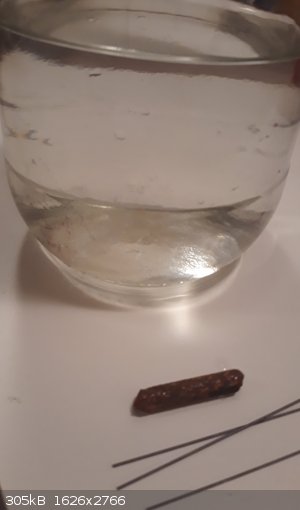
|
|
|
AJKOER
Radically Dubious
    
Posts: 3026
Registered: 7-5-2011
Member Is Offline
Mood: No Mood
|
|
After 5 minute MW some off-white scale developed on surface of the solution.
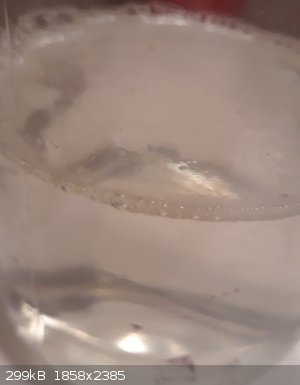
[Edited on 29-7-2019 by AJKOER]
|
|
|
AJKOER
Radically Dubious
    
Posts: 3026
Registered: 7-5-2011
Member Is Offline
Mood: No Mood
|
|
Some 3 hours later.
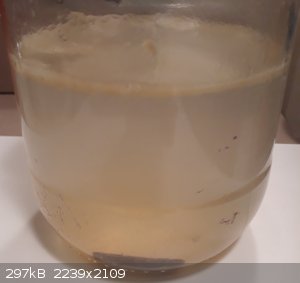
|
|
|
AJKOER
Radically Dubious
    
Posts: 3026
Registered: 7-5-2011
Member Is Offline
Mood: No Mood
|
|
Some 15 hours after start.
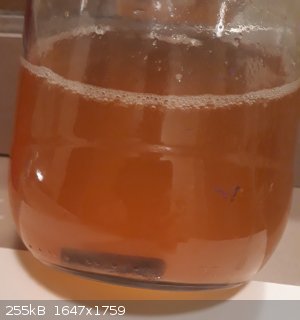
|
|
|
Ubya
International Hazard
    
Posts: 1232
Registered: 23-11-2017
Location: Rome-Italy
Member Is Offline
Mood: I'm a maddo scientisto!!!
|
|
instead of reading papers and citing them, and making an experiment without any measurements, controls etc do it the right way.
hydrogen peroxide is an oxydizer, iron or copper are oxydized by it and dissolve in acid, all your microwaves and carbon and "pinch of salt" do
nothing in my opinion, UNLESS you did the experiment scintifically, and did at least a few tests.
1) control, just iron or copper, acid and H2O2 (you want to test the differences with carbon and MW right?)
2)iron or copper, acid, H2O2 and carbon(different sources give different results?)
3)iron or copper, acid, H2O2 and MW
4)iron or copper, acid, H2O2, carbon and MW
... and so on
you need to verify all the variables
nobody listens to you because you do some random experiment, without any measurements, and spit mechanisms referring to papers that did a different
thing.
everybody here knows you like to speculate about radical reaction mechanisms, 99% of your posts and comments are about that, still, nobody is
interested, after 2685 messages you wrote, maybe 1% were considered usefull, why? because most of them are just useless. you like to speculate
mechanisms? perfect everyone has a favourite chemistry subject, but you chose on of the most complex and hard. to identify a mechanism you need
science, lots of It, lots of experiments and MATH, you can't simply say "this reacts to this and that, this forms a radical, this goes here and
there", back it up, not only with quotes from papers, you did an experiment right? do more of them! write down any difference and evaluate any
variables. look at nurdrage's work on sodium production, he hypotetized a mechanism, made LOTS of runs changing all the variables one by one, and
observed what changed, only doing this he found out that something in his mechanism didn't turn right, verified it, changed the mechanism,
experimented again, MADE A PREDICTION BASED ON HIS MECHANISM and he found a better catalyst.
now i don't know how many tests you do in your experiments, from what you write it doesn't seem much, maybe i'm wrong.
the thing i'm trying to say is, you need to show evidence, otherwise nobody is going to listen, and to do it you need to show how you did your
experiemnt, how any change in the system changed the outcome, show quantitative results (want to prove your methode produces more more Fe in solution
faster? titrate it and show me it vs the classical method)
plus all your mechanisms use radicals, radicals in solution are not that common, but i might be wrong as i know really little about them (i know
atmosphere chemistry and some organic chemistry reactions that use radicals, but not much else), how do you find out if the reaction is happening due
to radicals or due to other species?
is there a way to measure or test the presence of radicals in solution (or identify a specific radical)?
this is what makes all of this interesting, the science, not the speculation without a strong reason to back it up
---------------------------------------------------------------------
feel free to correct my grammar, or any mistakes i make
---------------------------------------------------------------------
|
|
|
AJKOER
Radically Dubious
    
Posts: 3026
Registered: 7-5-2011
Member Is Offline
Mood: No Mood
|
|
Ubya:
The reason I included so many pictures is so one does not have to master any of the science to see the results!
However, you are perfectly welcome to try an dissolve cast iron in vinegar without adding an electrolyte (NaCl) via standard heating in a narrow neck
vessel to ignore the role of oxygen or H2O2.
Many years ago, I slowly dissolved copper in vinegar in a period of days (or was it a week or more).
I actually recommend you experience such a standard chemical reaction approach to be impressed by the 5 minute path!!!
------------------------------------------------------------------------------------------------------------------------------------------------------
----------------
Also, this is chiefly a venture into electrochemistry, which is further microwave assisted, with recognition of the likely role of radicals.
Surprise, an electrochemical reaction proceeds (like a nail rusting) until there is no longer any available iron or oxygen or a source of H+. At that
point, a metal below Fe in the reactivity series, like Cu if present, will proceed to undergo an corrosion reaction until it is consumed, etc. Note,
the rate of the reaction does NOT follow the concentration until it is at a point of zero.
In electrochemistry, there can also be an annoying inception period during which there is no reaction, however, employing a MW, appears to obviate
this waiting period.
What is important, as I cited several times, is the relative ratio of surface area electrodes, which in the current context is the surface area of the
iron metal versus the carbon. This impacts the speed of corrosion reaction!
I did also noted, for information purposes, that I employed 240 ml of both household vinegar and H2O2, and produced a picture of the graphite rods and
size of the cast piece employed.
Now, an exact replication will still be hard as, I suspect, cast iron (that one can extract a sample) is not always available. However, removing the
zinc coating on select nails may provide a source.
[Edited on 29-7-2019 by AJKOER]
|
|
|
DraconicAcid
International Hazard
    
Posts: 4278
Registered: 1-2-2013
Location: The tiniest college campus ever....
Member Is Offline
Mood: Semi-victorious.
|
|
You mention a "weird non-ionic basic ferrous acetate", but I can't find anything in your wall of text that refers to it. Did you make this, or are
you just hypothesizing that you've created something weird?
Please remember: "Filtrate" is not a verb.
Write up your lab reports the way your instructor wants them, not the way your ex-instructor wants them.
|
|
|
AJKOER
Radically Dubious
    
Posts: 3026
Registered: 7-5-2011
Member Is Offline
Mood: No Mood
|
|
If you read the Wikipedia reference on the ferrous acetate, it stresses that it is non-ionic. Other sources note that is does not dissolve in acetic
acid, or is not too soluble, but apparently more soluble in 'other solvents'.
Stranger is the different in clarity of the pictures between the ferrous and ferric. This is not my blurry attempt at photography, I employed the same
camera for both, it is the solution that actually looks like a hair conditioner!
[Edited on 29-7-2019 by AJKOER]
|
|
|
Tsjerk
International Hazard
    
Posts: 3022
Registered: 20-4-2005
Location: Netherlands
Member Is Offline
Mood: Mood
|
|
@Ubya @Draconicacid; just let him go, it's not worth the time to go through his wall of shit and try to point out where he is wrong. He will come with
more shit were you will have to go through again in order to "not lose" the argument. He will bury you in shit. He did it before you started arguing
him, and he will go a mile further.
There are some, few, posts from AJOEKER that made sense. But a clock standing still is more often correct than... You get the point. AJOEKER is not
standing still, he is a minute off.
In the case of AJOEKER you win the argument by not replying. Is that a characteristic of a throll? Yes, but I don't think he is one. But still just
let him go.
|
|
|
AJKOER
Radically Dubious
    
Posts: 3026
Registered: 7-5-2011
Member Is Offline
Mood: No Mood
|
|
I am willing to remove the word 'Weird' from the title of this thread now.
Done, it is now 'Interesting' although some may find it otherwise.
-----------------------------------------------------------------------------------
I was not looking for a strange compound here, but decided to attempt a prep because of this very recent (May 2019) article at https://advances.sciencemag.org/content/5/5/eaav7689 . To quote:
"The higher OH yield in the presence of UV light might be due to a photo-Fenton–like reaction (R4), where Fe(III) and organic ligands, such as
acetate, which is a product of the initial Fenton-like reaction (R3), form a complex leading to the reduction of Fe and the formation of an organic
radical that will form OH.
Fe(III)+CH3C(O)O−+hυ→Fe(II)+CH3C(O)O→OH radical formation (R4) "
The above implies to me that UV light activated Ferric acetate may be of use as a source of photo induced hydroxyl radical creation and as a path to
recycling ferric to ferrous in a photo-fenton reaction.
Now, this is not unique, iron oxalate, a case in point, but if one has a good path to the basic iron acetate, that many be of interest to some.
[Edited on 30-7-2019 by AJKOER]
|
|
|
AJKOER
Radically Dubious
    
Posts: 3026
Registered: 7-5-2011
Member Is Offline
Mood: No Mood
|
|
Per a recent thread of mine:
Quote: Originally posted by AJKOER  |
......................
but decided to attempt a prep because of this very recent (May 2019) article at https://advances.sciencemag.org/content/5/5/eaav7689 . To quote:
"The higher OH yield in the presence of UV light might be due to a photo-Fenton–like reaction (R4), where Fe(III) and organic ligands, such as
acetate, which is a product of the initial Fenton-like reaction (R3), form a complex leading to the reduction of Fe and the formation of an organic
radical that will form OH.
Fe(III)+CH3C(O)O−+hυ→Fe(II)+CH3C(O)O→OH radical formation (R4) "
The above implies to me that UV light activated Ferric acetate may be of use as a source of photo induced hydroxyl radical creation and as a path to
recycling ferric to ferrous in a photo-fenton reaction.
Now, this is not unique, iron oxalate, a case in point, but if one has a good path to the basic iron acetate, that many be of interest to some.
[Edited on 30-7-2019 by AJKOER] |
The ferric acetate is recently cited because it apparently naturally occurs in clouds (authors fields include Atmospheric and Environmental
Sciences)!
I will not be surprised on a similar property for copper acetate (as Cu like Fe, is a transition metal, albeit not found significantly in clouds)
relating to a photo-fenton-type reaction, as it is based on copper, and not the classic iron fenton (or photo-fenton) reaction.
[Edited on 8-8-2019 by AJKOER]
|
|
|
unionised
International Hazard
    
Posts: 5102
Registered: 1-11-2003
Location: UK
Member Is Offline
Mood: No Mood
|
|
The wiki page distinguishes between the anhydrous material- which is not ionic and the hydrate- which probably is.
The so called "basic ferrous acetate" is a complex compound including H2O an OH in the structure.
Since you have a dilute solution...
So, you should probably "update" the title again.
I suggest
"I made rusty vinegar"
|
|
|
AJKOER
Radically Dubious
    
Posts: 3026
Registered: 7-5-2011
Member Is Offline
Mood: No Mood
|
|
Here is an updated picture of the solution.
An ebook notes that a good test for the acetate ion occurs on adding FeCl3. In the current case, given a small amount of NaCl presence in my solution
as an electrolyte, there could be some FeCl3 formed, resulting, per the source, in a deep red coloration. My reading of the reaction equation suggests
the red color is due to aqueous ferric acetate, which on heating (meaning also oxygen contact) forms a basic salt precipitate (also visible here).
Source: University Chemistry, Volume 1, by C. Parameshwara Murthy, page 296, at
https://books.google.com/books?id=0xl17YU8WzQC&pg=PA296&lpg=PA296&dq=fe(ch3coo)3&source=bl&ots=7Ik630KHTH&sig=ACfU3U20S2-H59kh
B85E4jzMFqXQNys6GQ&hl=en&sa=X&ved=2ahUKEwj-huKD4PTjAhViQt8KHbm-AycQ6AEwEXoECAoQAQ#v=onepage&q=fe(ch3coo)3&f=false
Wikipedia's makes a similar comment on the ferric acetate, to quote:
"The formation of the red-brown complex has long been used as a test for ferric ions.[4]"
So starting off, the solution was more brown and now increasingly red. Note, the solution was not reheated and kept in the dark, but in the continuing
presence of iron metal and the carbon rods. It was opened once to extract some solution for a photolysis experiment at which time it also displayed
more red coloration.
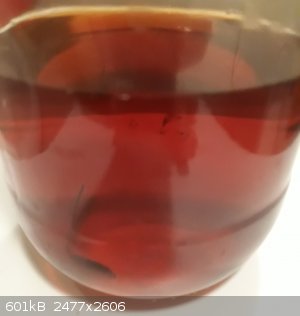
[Edited on 9-8-2019 by AJKOER]
|
|
|
|